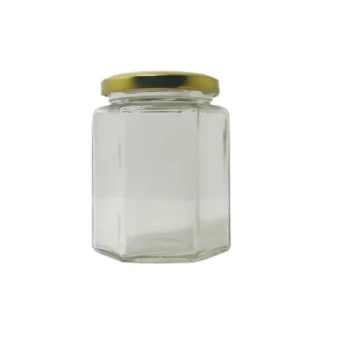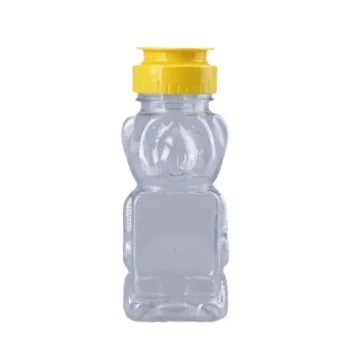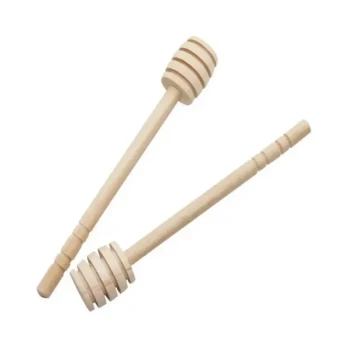The best way to store packaged honey is in an airtight container at a stable room temperature, between 65°F and 75°F. It is crucial to keep the container away from direct sunlight and any extreme temperature fluctuations to preserve its quality and prevent degradation.
Honey's remarkable shelf life is not guaranteed; it is a direct result of proper storage. The core goal is to protect its delicate chemical balance from three environmental factors: temperature, air, and light, which can otherwise lead to crystallization, fermentation, and flavor loss.
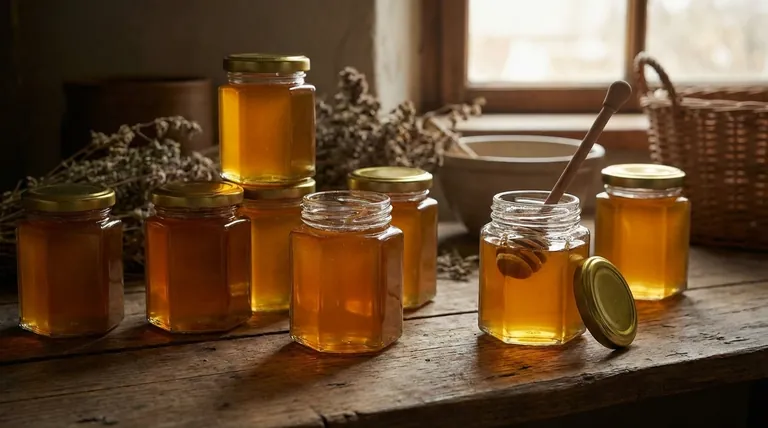
The Three Pillars of Honey Preservation
To understand best practices, we must look at the key environmental threats to honey's quality. Each recommendation is designed to mitigate a specific risk.
Temperature Stability is Non-Negotiable
The ideal temperature range for honey is 65°F to 75°F (18°C to 24°C). This narrow window is critical for maintaining its ideal consistency and chemical structure.
Extreme heat can degrade honey's delicate enzymes and aromas, while cold temperatures will accelerate the natural process of crystallization. While crystallization is not a sign of spoilage, it changes the texture and is often undesirable.
This principle extends beyond the pantry. Avoiding temperature extremes during shipping and on retail shelves is essential for delivering a high-quality product to the end consumer.
The Importance of an Airtight Seal
Honey is hygroscopic, meaning it readily absorbs moisture from the surrounding air. An airtight container is fundamental to preventing this.
If honey's water content rises too high, naturally occurring yeasts can become active, leading to fermentation. A tight lid also protects the honey from absorbing strong odors from its environment and prevents oxidation, which can alter its flavor.
Protecting Against Light Degradation
Direct sunlight and other sources of UV light can be surprisingly damaging to honey. This exposure can break down important enzymes, like glucose oxidase, which contributes to honey's stability.
Storing honey in a dark cupboard or pantry is sufficient. For maximum protection, especially for high-value honey, using opaque or dark-colored containers provides an additional barrier against light.
Choosing the Right Container Material
The container itself plays a significant role in preservation. The choice often involves a balance between ideal protection and practical market considerations.
Glass: The Gold Standard
Glass jars with tight-fitting lids are considered the ideal storage solution. Glass is inert, meaning it will not react with the honey or impart any unwanted flavors.
It is also non-porous, providing an excellent barrier against moisture and air. As mentioned, colored or opaque glass offers superior protection against light damage.
Food-Grade Plastic: The Practical Alternative
Plastic containers are widely used due to their low cost, light weight, and resistance to breakage. They are often transparent, allowing customers to see the honey's color and clarity, which is a key purchasing factor.
However, it is absolutely critical to use only food-grade plastic. Non-food-grade plastics can leach chemicals, and some plastics are more permeable to air and odors than glass over the long term.
What to Strictly Avoid
Never store honey in containers made of metal (unless they have a food-safe lining) or non-food-grade plastic. Certain metals can react with the slight acidity of honey, causing oxidation and spoiling its taste.
Understanding the Trade-offs
In a commercial setting, perfect preservation must often be balanced with consumer appeal and practicality.
Visibility vs. Preservation
There is a direct trade-off between the best container for preservation (opaque glass) and the best for retail appeal (clear glass or plastic). Consumers want to see the product they are buying.
The Retail Environment Compromise
For most retail situations where honey turnover is relatively quick, a clear container is an acceptable compromise. The key is to manage the other factors.
Retailers should be advised to keep honey displays away from sunny windows and hot lights to mitigate the risks of temperature and light degradation.
Making the Right Choice for Your Goal
Your storage strategy should align with your specific objective for the honey.
- If your primary focus is long-term archival or premium quality: Use airtight, colored, or opaque glass jars stored in a dark, temperature-controlled environment.
- If your primary focus is commercial retail and consumer appeal: Use clear, food-grade glass or high-quality plastic, but control for light and heat during shipping and display.
- If your primary focus is low-cost, single-use packaging: Food-grade plastic sachets are viable but offer the least long-term protection and should be intended for quick consumption.
By actively managing these environmental factors, you ensure your honey remains as stable and flavorful as the day it was harvested.
Summary Table:
| Storage Factor | Best Practice | Why It Matters |
|---|---|---|
| Temperature | 65°F - 75°F (18°C - 24°C) | Prevents crystallization & flavor degradation. |
| Container | Airtight glass or food-grade plastic | Protects against moisture, odors, and fermentation. |
| Light | Store in a dark cupboard or use opaque containers | Preserves delicate enzymes and prevents quality loss. |
Protect Your Honey's Quality and Your Business's Reputation
As a commercial apiary or beekeeping equipment distributor, your product's quality is your brand. Proper storage is the final, critical step in delivering premium honey to your customers.
HONESTBEE supplies the durable, airtight containers and storage solutions you need to implement these best practices at scale. From wholesale glass jars to food-grade plastic pails, our equipment is designed to protect your honey's integrity during shipping, storage, and retail display.
Let's discuss your specific needs. Contact our wholesale experts today to find the right packaging solutions for your operation.
Visual Guide
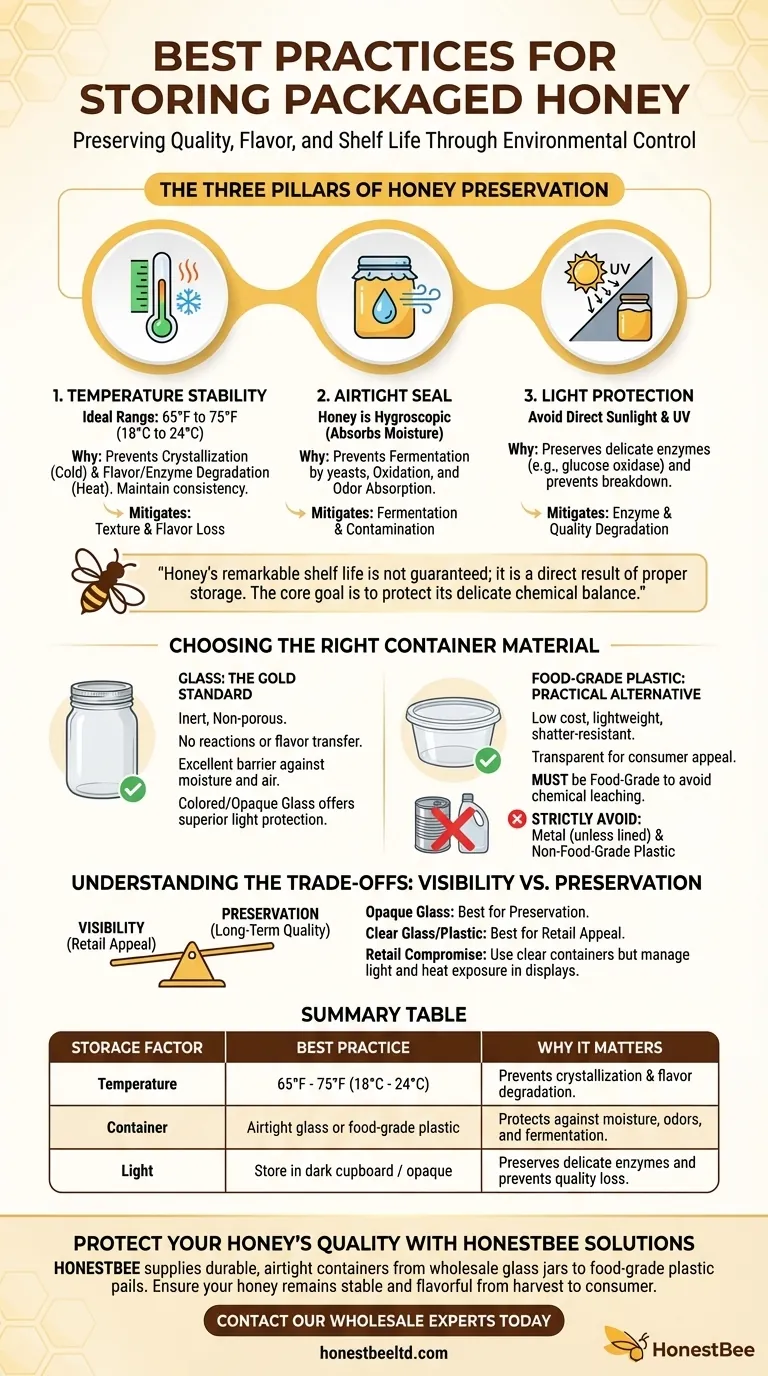
Related Products
- Hexagonal Glass Honey Jars with Metal Lug Caps Elegant Versatile Packaging
- Classic Drum Shaped Glass Honey Jar with Airtight Lid
- Inverted Squeezable Honey Jar with No Drip Flip Top Cap for Easy Pouring
- Classic Honey Bear Jars with Flip Top Dispensing Cap for Liquid Sweeteners
- Plastic Honey Gate Spout with Wing Nut for Beekeeping Honey Bucket
People Also Ask
- What are the advantages of using glass jars for honey packaging? Preserve Purity & Elevate Your Brand
- What are the common types of honey packaging? A Guide to Glass, Plastic, Pouches & Tins
- What makes raw honey more aesthetically appealing than processed honey? Discover the Beauty of Authenticity
- How many jars of honey do you get from a hive? Unlock Sustainable Harvesting Secrets
- What is the term for honey can absorb moisture from the air? Understanding Hygroscopy
